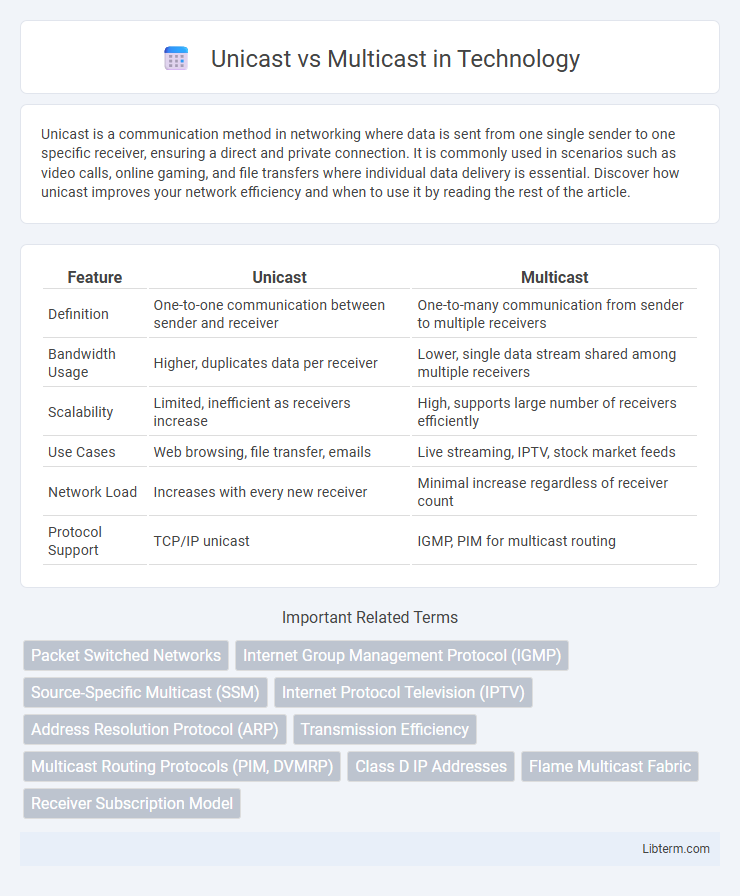Unicast is a communication method in networking where data is sent from one single sender to one specific receiver, ensuring a direct and private connection. It is commonly used in scenarios such as video calls, online gaming, and file transfers where individual data delivery is essential. Discover how unicast improves your network efficiency and when to use it by reading the rest of the article.
Table of Comparison
| Feature | Unicast | Multicast |
|---|---|---|
| Definition | One-to-one communication between sender and receiver | One-to-many communication from sender to multiple receivers |
| Bandwidth Usage | Higher, duplicates data per receiver | Lower, single data stream shared among multiple receivers |
| Scalability | Limited, inefficient as receivers increase | High, supports large number of receivers efficiently |
| Use Cases | Web browsing, file transfer, emails | Live streaming, IPTV, stock market feeds |
| Network Load | Increases with every new receiver | Minimal increase regardless of receiver count |
| Protocol Support | TCP/IP unicast | IGMP, PIM for multicast routing |
Introduction to Unicast and Multicast
Unicast transmits data from a single sender to a single receiver, ensuring dedicated communication between two devices in a network. Multicast, by contrast, sends data from one sender to multiple specific receivers simultaneously, optimizing bandwidth by distributing information only to interested clients. Both unicast and multicast serve distinct roles in network communication, with unicast ideal for one-to-one connections and multicast efficient for one-to-many data distribution.
Understanding Unicast Communication
Unicast communication involves a one-to-one data transmission where a single sender sends data directly to a single receiver over a network, ensuring dedicated bandwidth and reduced data collisions. It is commonly used in applications like email, web browsing, and file transfers due to its reliable and straightforward delivery model. This method contrasts with multicast, which sends data to multiple recipients simultaneously, optimizing bandwidth for group communications.
Understanding Multicast Communication
Multicast communication efficiently transmits data from one sender to multiple specified receivers by using a single data stream, reducing bandwidth consumption compared to unicast's one-to-one transmission. It relies on multicast group addresses within IP networks, typically using protocols such as IGMP (Internet Group Management Protocol) for IPv4 or MLD (Multicast Listener Discovery) for IPv6, to manage group memberships dynamically. This approach enables scalable distribution of multimedia streaming, online gaming, and real-time data feeds by minimizing network load and ensuring synchronized delivery to all multicast group members.
Key Differences Between Unicast and Multicast
Unicast communication involves one-to-one data transmission, where a single sender transfers data to a single receiver, ensuring point-to-point delivery and individualized routing paths. Multicast communication uses one-to-many transmission, sending data from one sender to multiple specified receivers simultaneously, optimizing bandwidth by reducing duplicate data streams. Key differences include unicast's higher bandwidth consumption due to multiple separate streams and multicast's efficiency in resource utilization by delivering a single stream to multiple hosts.
Advantages of Unicast
Unicast communication offers precise data delivery by establishing a direct connection between a single sender and a single receiver, ensuring reliable and secure transmission. Its advantages include simplified network management, reduced bandwidth consumption on the receiving end, and better control over the communication session. This targeted approach is ideal for applications requiring guaranteed data integrity and personalized interactions, such as VoIP calls and private video streaming.
Advantages of Multicast
Multicast significantly reduces bandwidth consumption by delivering data packets to multiple recipients simultaneously without duplicating streams, making it highly efficient for large-scale live video streaming and real-time data distribution. This method optimizes network resource utilization by minimizing traffic loads and lowering overall infrastructure costs compared to unicast, which requires separate transmissions for each recipient. Multicast enhances scalability and performance in enterprise networks and content delivery systems by facilitating synchronized data delivery to numerous clients with minimal delay.
Use Cases for Unicast
Unicast communication is ideal for one-to-one connections, such as video streaming services where a unique data stream is sent to each viewer to ensure personalized content delivery and secure transmission. Use cases include online gaming, where low latency and direct device-to-device communication are critical for real-time interactions. Enterprise applications like remote desktop access and private file transfers also rely on unicast for reliable, point-to-point data exchange.
Use Cases for Multicast
Multicast is highly efficient for streaming live events, such as sports broadcasts and webinars, by delivering data simultaneously to multiple recipients without overloading the network. It is commonly used in IPTV services and videoconferencing to optimize bandwidth and reduce server load. Multicast also benefits large-scale software distribution and real-time financial data feeds, where identical content must reach numerous end users simultaneously.
Challenges and Limitations
Unicast communication faces scalability issues due to bandwidth inefficiency when sending identical data streams to multiple receivers, causing network congestion and increased latency. Multicast addresses these limitations by transmitting a single copy of data to multiple recipients, but it requires complex management of group memberships and lacks universal support across all routers and devices, leading to deployment challenges. Security concerns also arise in multicast environments because data is distributed to multiple endpoints, complicating access control and encryption.
Choosing the Right Communication Method
Choosing the right communication method depends on the network's scale and data distribution needs; unicast sends data directly between a single sender and receiver, ensuring precise delivery ideal for one-to-one communication. Multicast efficiently transmits data from one sender to multiple receivers simultaneously, reducing bandwidth usage in applications like streaming video or live broadcasts. Understanding traffic patterns and resource constraints helps determine whether unicast's individualized delivery or multicast's group-based approach is more effective for a given scenario.
Unicast Infographic

 libterm.com
libterm.com